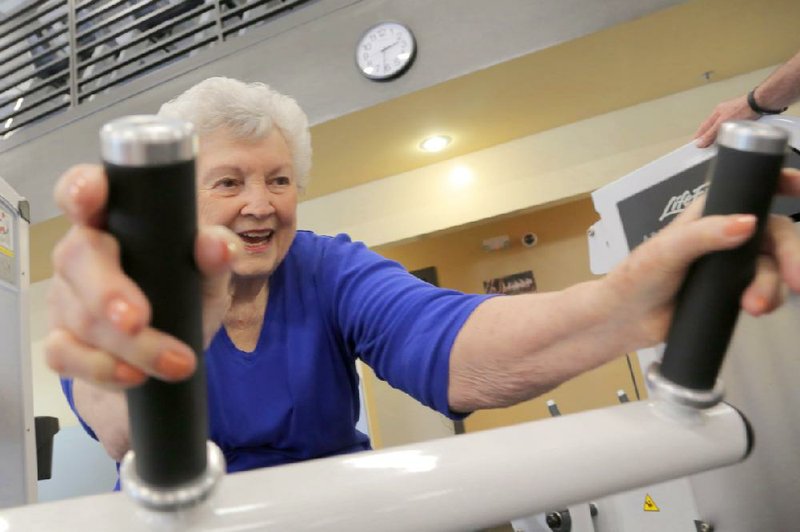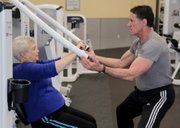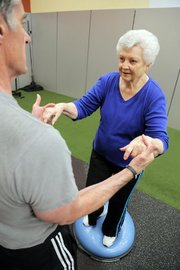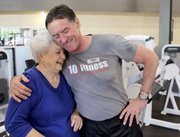It's a decent crowd for a weekend afternoon at the gym: brightly clad patrons drifting from exercise to exercise, moving in time with the music flowing from overhead speakers. A class stretches and gyrates in the dance room while on the weight floor, hardcore lifters snarl and grunt from underneath barbells and dumbbells.
Faye Taylor of Maumelle is here, too. You can set your watch by the 88-year-old, who has been training at 10 Fitness' Maumelle location for 15 months, becoming a fixture in the process.
Between sets, she remembers it was a day just like today she seized upon an impulse and walked in here for the first time, but Taylor herself is night-and-day different from then.
"I was having trouble getting around; I couldn't get up by myself, couldn't sit down by myself, couldn't get out of the car by myself," she said. "I decided I'd go into assisted living, but I went and looked, and I didn't like it. So we were driving down the boulevard, my husband and I, and I said, 'Take me in there.'
"I walked in and whoever was at the desk said, 'May I help you?' and I said, 'Well, I don't know, I need some help. Do you think you can help me?'"
A farm girl who excelled at three sports in high school and walked everywhere before a blood clot corralled her into a sedentary senior-citizen existence, Taylor couldn't go more than 10 minutes on a treadmill. She thought a trainer might help, but with one condition.
"I said, 'Don't give me one of those 20-year-old [trainers] out there because I can't do what they do,'" she said. "They said, 'We've got just the guy for you.'"
Enter Jim Thompson, 66, a nine-year veteran of the personal training business, who is certified through the National Exercise Trainers Association.
Given his professional demeanor and the smattering of gray in his hair, Thompson is the trainer of choice at the Maumelle gym for a clientele that averages somewhere north of 70.
"Most of my clients are referred to me here by the gym because of the demographic of the people that I work with," he said. "My focus in working with those people is to give them a better quality of life. That's what I'm all about."
There's ample evidence to suggest Thompson and people like him could be the next big thing in fitness. Millions of baby boomers, who on balance have been far more interested in exercise than their parents, represent a potential windfall for gyms. The industry has taken notice, albeit slowly, using older people
in advertising and tailoring some programs to the over-50 set.
But marketing to a potentially lucrative demographic is one thing; serving it is another. Some gyms have turned to older trainers to deliver that service, and the reasons are fairly straightforward.
"My clients look at me and they know that I've walked the walk, not just talked the talk," Thompson said. "When I share with them some of my history, I think they feel a little more comfortable working with me because I'm not a guy who's gonna get out there and hurt them. I'm not a guy that's gonna get out there and try to prove something. I think they realize that I don't just sympathize, but I can truly empathize with them."
Is the senior citizen as fitness trainer becoming an industry trend?
Statistics are difficult to come by, but national trade groups and certifying entities suggest that the number of older trainers appears to be growing. According to IDEA, a national fitness professionals group, the number of trainers over 50 attending its World Fitness Convention has increased from 5 percent of all participants in 2004 to 12 percent in 2011. The American Council on Exercise, another certification body, has started offering discounts on training materials to AARP members and most certification programs offer some kind of education module addressing the older client.
One possible explanation is that the corps of fitness instructors could be graying. But in Arkansas, Thompson isn't the only older trainer who hasn't been a trainer since he was young.
'A LITTLE MORE MEANING'
Education and skills gleaned from earlier careers can be advantages for personal trainers who take up the job later in life.
Kathleen Rea, owner of Regeneration Fitness in North Little Rock and a former aerospace engineer, has a doctorate in biomedical engineering as well as a doctorate in engineering mechanics originally earned for use in another field. When funding for that job ran out, she was left wondering what to do.
"I found myself looking for a job but not wanting to leave the area because I'm here for my family," she said. "I tried to figure out what can I do to stay right here, what are my skills and what are the things that are important to me.
"I'd always been interested in fitness. It was always kind of a hobby. At that point in my life I just wanted to do something that had a little more meaning to me."
Rea, 56, started Regeneration Fitness eight years ago after working with a friend with knee problems who suggested such a business would fill a need. She expected to attract like-minded, very active middle-agers, but what she got surprised her.
"The group that I thought I would primarily be focused on would be my age group," she said. "But it has evolved to be more clients who are in their 70s.
"What I'm surprised about that age group is they probably had the mentality all their lives that when they get to a certain age, they're not going to be able to do this or that anymore, and now they're recognizing that might not be true."
As once fatalistic beliefs about health and wellness break down, Rea said, such clients stick fast to their desire to have a trainer closer to their own age than their grandchildren's age.
"I honestly don't think the business would work if I was younger, and that's for a couple of reasons," she said. "I was once that 25-year-old, and I know that I couldn't have related to these clients back then. And the other thing is, I've had people come in and say to me, 'I'm not looking for some rah-rah cheerleader trainer. I want someone who can actually understand me.'
"I think I put them at ease; I'm pretty low-key in my approach, and I'm not real pushy. I go gently and firmly, guide people along to push their limits, which is something that age group is more comfortable with."
GENERATION GAP
The U.S. Census estimates that 14.5 percent of Arkansans are 65 or older. But elder-focused fitness programs are still relatively hard to find in central Arkansas, said Edward Drangle, 64, owner of Ageless Health & Fitness Inc. in Little Rock. His company, providing physical therapy and personal training, is a rarity.
"If you look, [gyms] rarely change their services to accommodate seniors; they're still doing the same programming as they have always done, and all of the marketing still goes to the 25-year-old age group," he said. "So that's a clue that says this is an underserved population.
"You've got this huge influx of people who have the adequate income and come to these gyms, but they don't do any programming for them. I've talked to a number of different organizations locally about doing some of that kind of programming, and they're just really reluctant and hesitant because it's so new to them."
A Chicago native and former competitive weightlifter, Drangle is a licensed physical therapist whose 9-year-old company employs five trainers currently serving clients ranging from 50 to 94. The growth of his firm -- 30 percent last year alone, with a waiting list -- makes finding qualified trainers a priority for him and here, too, the generation gap presents a thorny challenge, sometimes just in getting to the end of the interview.
"Just to be honest with you, we interview trainers all the time and I'll talk to some of them and they think they know it all because they have a four-year degree," Drangle said. "I'm like, I was a physical therapist before you were born, I've been a personal trainer for 38 years, I've won weightlifting championships all over the country and I've written a couple of books. You're not paying attention."
Such exchanges not only suggest the difficulties many younger trainers can have in relating to older clients, but the versatility that life experience shapes. Unlike their younger counterparts, older trainers don't have as much trouble crossing age lines, as Drangle, Thompson and Rea successfully demonstrate by having trained the occasional 30- or 40-something client.
"Younger trainers don't 'get it' yet because they don't have the background and they don't have the experience to get it; it's 'do what I do and you'll look like me,'" Drangle said. "When you're 25 and you go in the gym, have a hard workout and you come back the next day and say, 'Oh man, you killed me,' everybody is like 'yeah! Cool!'
"When you're 65 years old and you've got thinning cartilage and it's sore and achy, you may have created inflammation in your joint [with that killer workout]. That isn't going to just go away; it begins a degenerative process that will keep a person from activity.
"So, when you're looking at this group of people, you're looking at a different set of goals."
ActiveStyle on 04/18/2016



